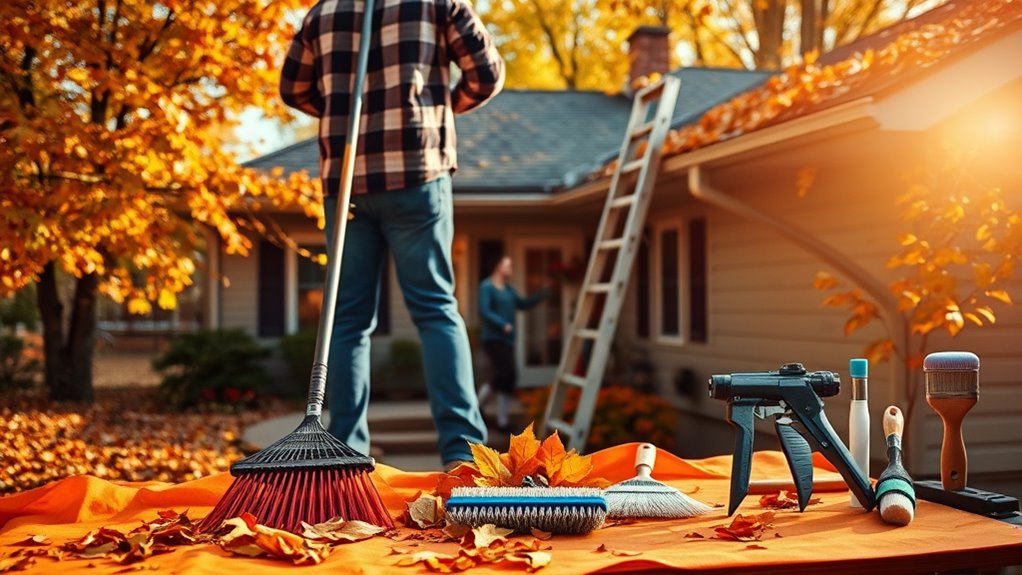A seasonal home maintenance checklist helps you keep your home safe, efficient, and well-maintained year-round. It includes tasks like inspecting your roof and gutters, weatherproofing windows and doors, servicing your HVAC system, preparing plumbing, and winterizing outdoor fixtures. Don’t forget safety checks for smoke and carbon monoxide detectors. Following this plan will prevent costly repairs and improve your home’s comfort. Keep going to discover detailed steps so you can confidently prepare for every season.
Key Takeaways
- Inspect and repair the roof, siding, gutters, and seals to prevent water damage and improve energy efficiency.
- Service HVAC systems and prepare plumbing for seasonal temperature changes to ensure optimal performance.
- Clean and maintain gutters and downspouts to prevent clogging and water pooling around the foundation.
- Prepare lawns, gardens, and outdoor fixtures by winterizing equipment and protecting plants from cold damage.
- Test smoke and carbon monoxide detectors, replacing batteries and ensuring safety devices are fully operational.
Spring Cleaning and Exterior Maintenance
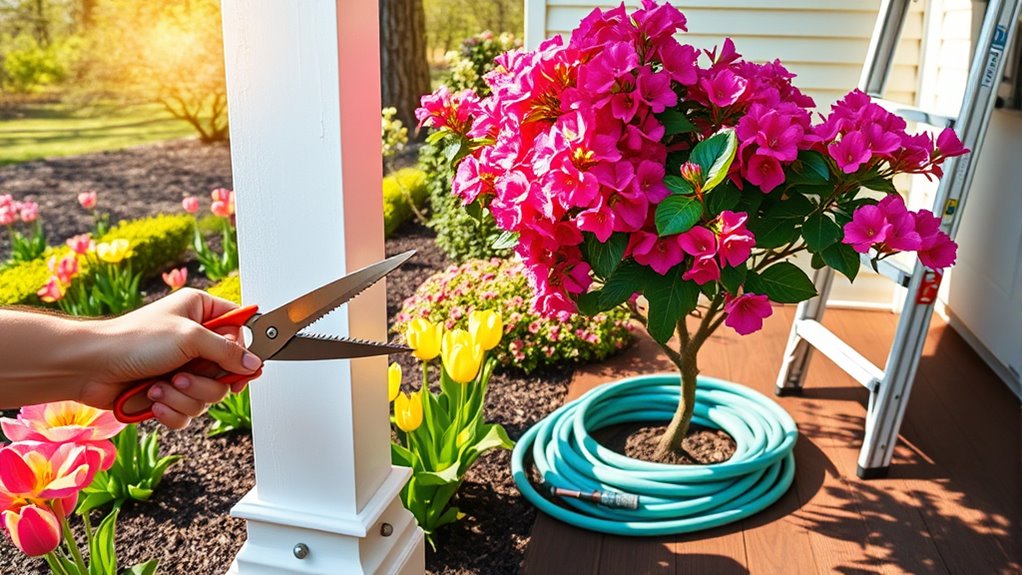
After a long winter, it’s essential to give your home’s exterior a thorough cleaning and inspection. Start by checking your chimney for any damage or creosote buildup; scheduling a chimney inspection guarantees safe operation and prevents potential fire hazards. While you’re at it, evaluate your attic ventilation—proper airflow reduces moisture, prevents mold, and maintains energy efficiency. Clear debris from gutters and power wash siding to remove dirt and grime accumulated during winter. Trim overgrown branches that could damage your home or clog gutters. Inspect roof shingles for damage or missing pieces. Additionally, consider reviewing your home’s air quality to ensure good indoor environments as seasons change. These steps not only boost curb appeal but also help catch issues early, saving you money on repairs later. Prioritize these tasks to keep your home safe, efficient, and looking its best for the season ahead.
Checking and Servicing HVAC Systems
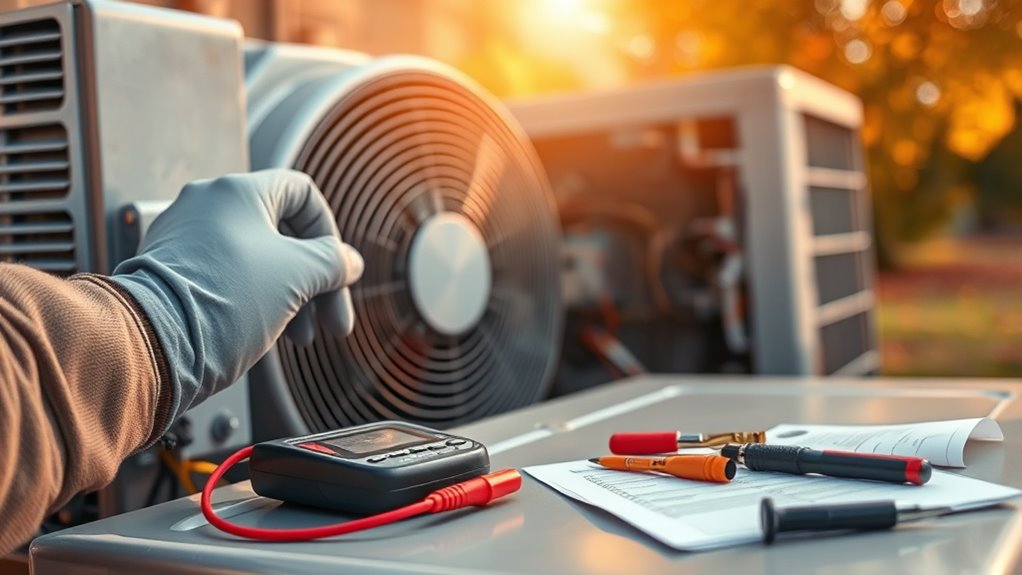
With exterior maintenance complete, it’s the perfect time to turn your attention to your HVAC system. Start by inspecting your ducts for leaks or blockages, as a duct inspection can notably improve HVAC efficiency. Replace or clean filters to ensure ideal airflow and prevent strain on your system. Consider scheduling a professional tune-up to check refrigerant levels, thermostat calibration, and overall functioning. Regular servicing helps your HVAC run smoothly, reduces energy costs, and extends its lifespan. Don’t forget to clean vents and registers, removing dust and debris that can hamper airflow. Ensuring your system maintains optimal color accuracy can also improve overall performance. Taking these steps now ensures your system operates efficiently all season long, keeping your home comfortable while saving you money on energy bills.
Inspecting and Cleaning Gutters and Downspouts

To keep your gutters functioning properly, you should focus on preventing clogs and cleaning them regularly. Using proper techniques, like removing debris safely and flushing the system, makes the job easier and more effective. Keeping up with these tasks guarantees your gutters and downspouts protect your home from water damage. Regular maintenance of gutters also helps prevent potential issues with clogged filters or debris accumulation that can impair their performance.
Clog Prevention Tips
Have you checked your gutters and downspouts recently? Regular inspections help prevent drain clogs that can lead to water damage or sewer backups. Keep debris like leaves and twigs out of your gutters to guarantee proper flow. Installing gutter guards can also reduce buildup and make maintenance easier. Additionally, make sure downspouts direct water away from your foundation to avoid pooling and potential issues. Using diverse planters made from recycled materials can complement your home’s exterior while supporting sustainable practices.
Proper Cleaning Techniques
Regularly inspecting and cleaning your gutters and downspouts is essential to prevent clogs and water damage. Use effective cleaning tools like a gutter scoop, stiff brush, and garden hose to remove debris and ensure proper flow. When dust removal is needed, a leaf blower can simplify the process, especially in hard-to-reach areas. Always check for obstructions and leaks, and clear out any accumulated debris. To stay organized, consider the following:
| Step | Tools Needed | Tips |
|---|---|---|
| Inspect gutters | Ladder, flashlight | Look for damage or sagging |
| Remove debris | Gutter scoop, gloves | Clear thoroughly |
| Flush downspouts | Garden hose | Ensure unobstructed flow |
| Check for leaks | Sealant, repair kit | Fix minor issues promptly |
| Dust removal | Leaf blower, brush | Keep gutters dust-free |
Proper maintenance maintains your home safe and prevents costly repairs. Regular inspections can also help identify potential issues early, such as clogged gutters that may lead to water damage or mold growth.
Lawn and Garden Preparation
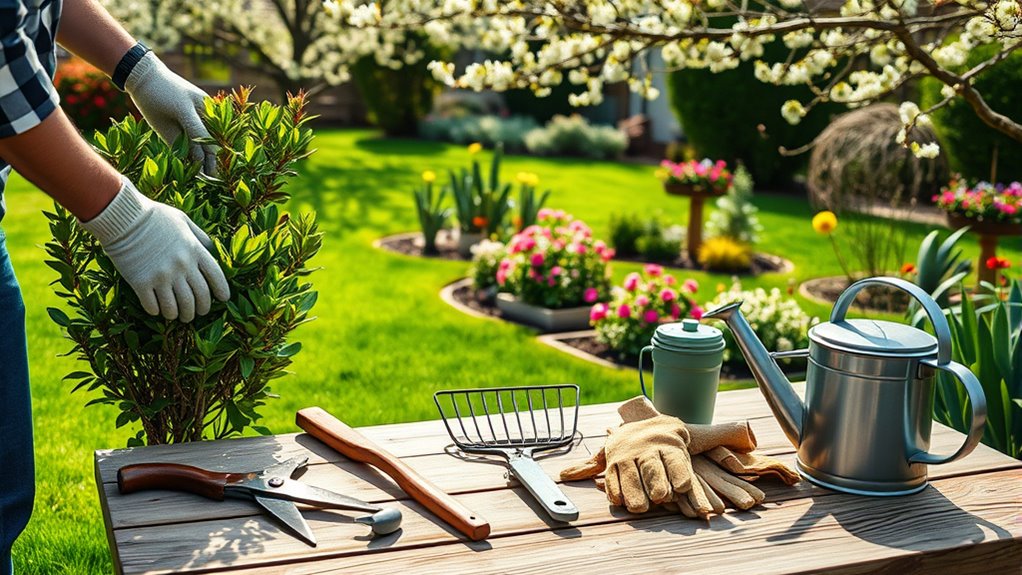
Now is the perfect time to prepare your lawn and garden for the upcoming season. Reseed and overseed your lawns to encourage healthy growth, and get your garden beds ready for planting. Don’t forget to prune trees and shrubs to promote strong, new growth. Incorporating sustainable gardening practices can help conserve resources and support local ecosystems.
Reseed and Overseed Lawns
To guarantee a lush, healthy lawn come spring, it’s vital to reseed and overseed now. Start by aerating your lawn to loosen compacted soil, enhancing seed contact and growth. When selecting seeds, choose a variety suited to your climate and sun exposure to maximize results. Proper seed selection promotes strong, resilient grass. After aeration, spread the seed evenly across your lawn, focusing on thin or bare patches. Water thoroughly to help the seeds germinate and establish roots before winter. Regular watering and maintenance will give your lawn a head start for the upcoming season. Additionally, choosing the right seed involves considering the specific grass type that performs well in your local climate.
Prepare Garden Beds
Preparing your garden beds is essential to guarantee healthy growth when planting season arrives. Start by testing your soil to determine its pH and nutrient levels, ensuring your plants will thrive. Based on the results, amend the soil as needed, adding organic matter or adjusting pH levels. Incorporate compost using effective composting techniques, such as turning your compost regularly to accelerate decomposition and enrich the soil naturally. Clear out weeds, rocks, and debris to create a clean planting area. Loosen the soil to improve aeration and drainage, making it easier for roots to grow. Properly prepared beds promote strong plant development and higher yields, setting a solid foundation for your garden. Taking these steps now saves time and effort later in the growing season. Additionally, maximizing space and organization in your garden beds can lead to more efficient planting and easier maintenance throughout the season.
Prune Trees and Shrubs
Pruning trees and shrubs is a vital step in spring lawn and garden preparation that promotes healthy growth and improves plant structure. Proper tree pruning and shrub trimming remove dead or damaged branches, encourage new growth, and shape your plants for better airflow and sunlight exposure. When pruning, focus on cutting just above a node or branch fork to promote strong healing. Use sharp tools to make clean cuts and prevent disease. Regular pruning also helps control size and prevents overgrowth. Remember, timing matters—avoid heavy pruning during early bloomers to protect flowering buds. Incorporating these practices into your routine can improve plant health and disease prevention.
Weatherproofing and Sealing Windows and Doors
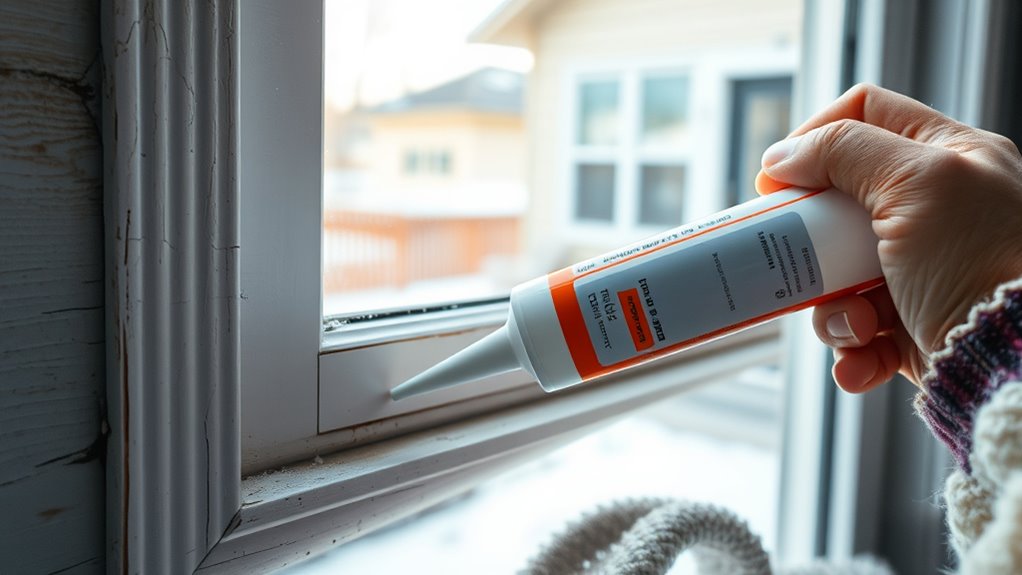
As temperatures drop, ensuring your windows and doors are properly sealed becomes essential for maintaining indoor comfort and energy efficiency. Start by installing storm windows to add an extra layer of protection against drafts and cold air. Check for gaps around window frames and use weatherstripping or caulk to seal leaks. Door insulation is equally important; add door sweeps or draft stoppers to keep cold air out and warm air in. Replace or repair damaged weatherstripping on doors and windows to prevent heat loss. These simple steps can considerably reduce heating costs and improve comfort during colder months. Remember, sealing your home now prevents drafts, keeps your home warmer, and helps you save energy throughout the season.
Inspecting Roof and Siding for Damage
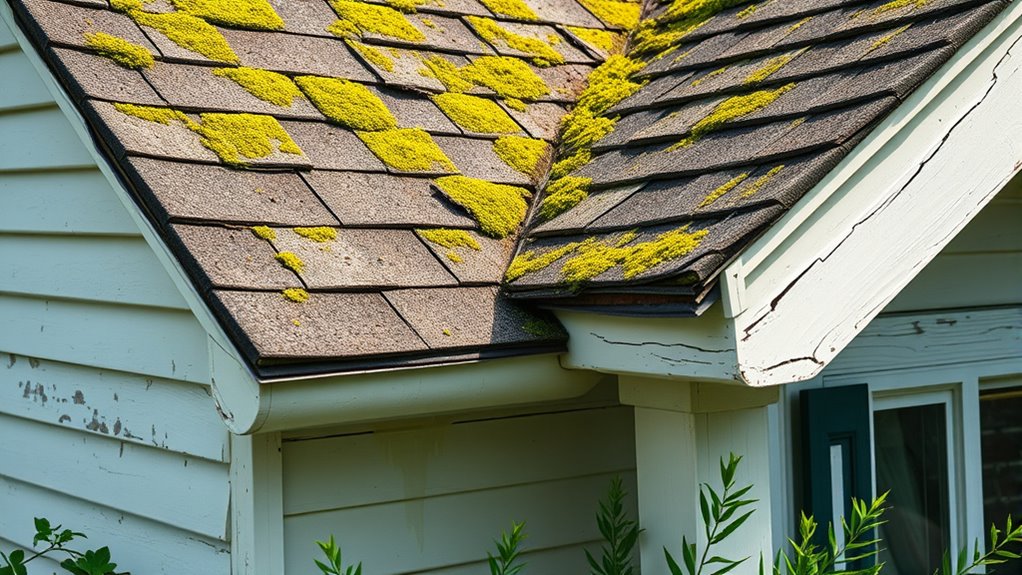
After sealing your windows and doors, it’s important to turn your attention to the roof and siding to catch any damage before winter weather worsens it. Begin with a thorough inspection for storm damage, such as missing shingles, cracked siding, or dents from hail. Look for signs of water intrusion, like stains or mold, which indicate compromised areas. Regular roof inspections help identify weak spots before leaks develop. Don’t forget to check the siding for cracks, warping, or loose panels that could let moisture in. Addressing these issues early prevents further deterioration and costly repairs later. Staying vigilant now keeps your home protected and ready for the cold months ahead. Proper maintenance also supports your overall net worth growth by preserving your property’s value over time.
Preparing Plumbing for Seasonal Changes
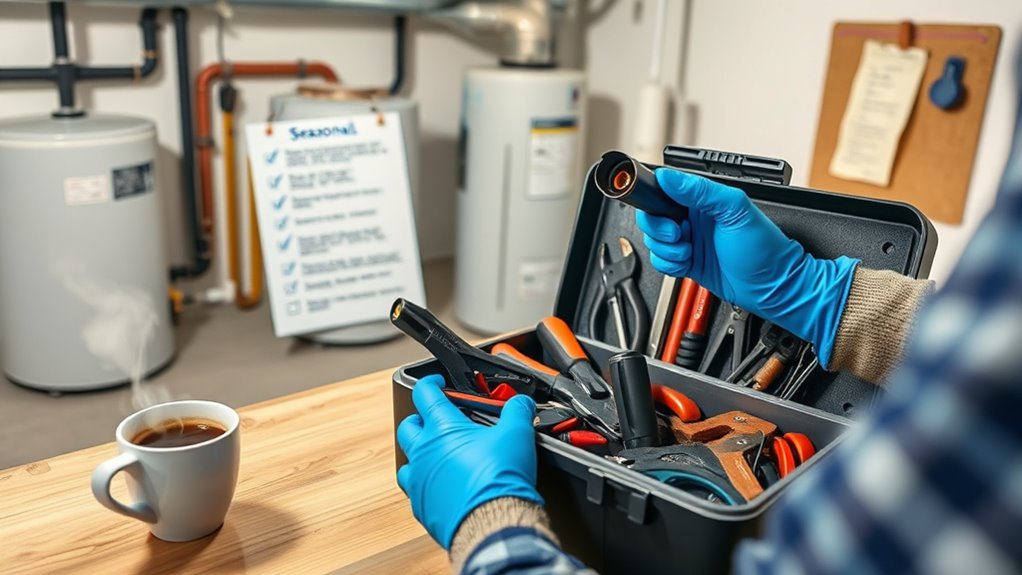
Preparing your plumbing for seasonal changes is essential to prevent costly damage during colder months. Start by inspecting your drainage systems for clogs or leaks, ensuring water flows freely away from your home. Proper drainage prevents backups that can cause water damage. Next, add pipe insulation to exposed pipes, especially those in unheated areas like basements, garages, and attics. Insulation keeps pipes warm and reduces the risk of freezing and bursting during cold snaps. Also, disconnect outdoor hoses and drain outdoor faucets to avoid ice expansion damage. Consider shutting off the main water supply to outdoor lines if you won’t be using them during winter. Taking these steps safeguards your plumbing system, saves money, and avoids inconvenient plumbing emergencies when temperatures drop.
Testing Smoke and Carbon Monoxide Detectors

Have you tested your smoke and carbon monoxide detectors recently? Regular testing is essential for your safety. Start by pressing the test button on each detector to verify they sound correctly. Proper smoke detector placement is key—install smoke alarms on every level and outside sleeping areas. For carbon monoxide safety, position detectors near bedrooms and on every floor where fuel-burning appliances are used. Remember to replace batteries annually or as needed. Dust and debris can interfere with detectors, so clean them gently with a soft cloth. Regular testing and correct placement help ensure your home’s safety in emergencies. Don’t forget, a working smoke detector and carbon monoxide alarm can be lifesavers during a fire or CO leak. Your vigilance keeps your home safe year-round.
Winterizing Outdoor Fixtures and Irrigation Systems
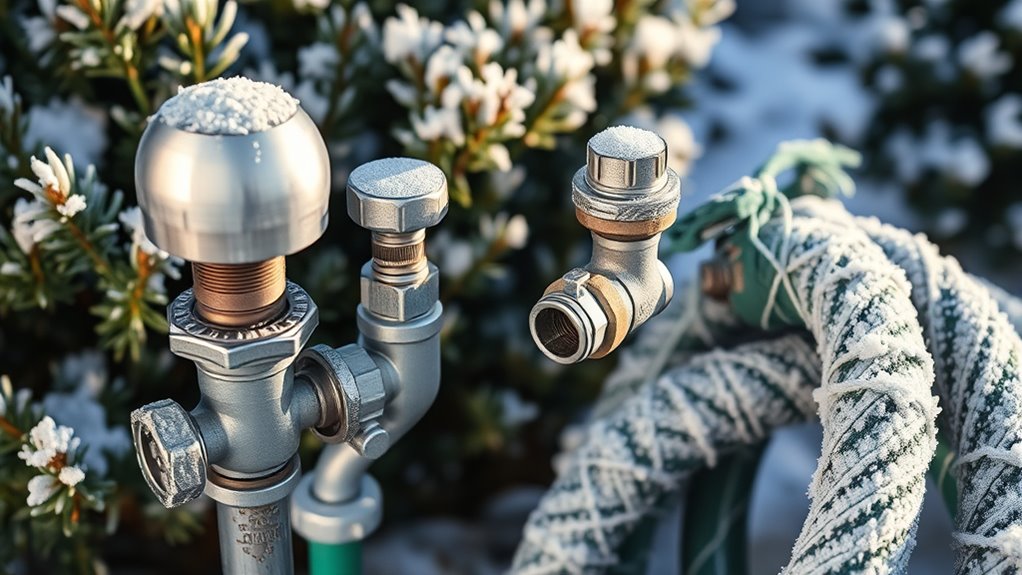
As temperatures drop, it’s crucial to prevent freezing damage to your outdoor fixtures and irrigation systems. You should drain and cover equipment to keep water from expanding and causing cracks. Taking these steps now will save you time and money when spring arrives.
Preventing Freezing Damage
When temperatures drop, outdoor fixtures and irrigation systems are vulnerable to freezing damage that can lead to costly repairs. To prevent this, you should winterize properly. Start by applying pipe insulation to exposed pipes to keep them warm. Use antifreeze application in sprinkler lines and drains to prevent water from freezing and expanding. Make sure to drain hoses and store them indoors. Additionally, disconnect outdoor hoses and shut off water supplies to outdoor fixtures. Taking these steps helps avoid burst pipes and damage that can be expensive to fix. Regularly inspecting and maintaining your outdoor systems ensures they stay protected throughout the cold months.
- Apply pipe insulation around vulnerable pipes
- Use antifreeze in sprinkler lines
- Drain and store hoses properly
Drain and Cover Equipment
To effectively winterize your outdoor fixtures and irrigation systems, start by draining all water from hoses, sprinklers, and other equipment to prevent freezing and cracking. Remove hoses and disconnect them from faucets, then drain any remaining water. Use drain covers on outdoor drains and spigots to keep debris out and prevent freezing. Inspect your equipment thoroughly, checking for leaks or damage, and repair any issues before winter. Pay special attention to sprinkler heads and valves, ensuring they are completely drained or winterized with compressed air if necessary. Cover exposed equipment with insulated covers or blankets to provide extra protection. Proper drainage and a careful equipment inspection help ensure your outdoor systems survive the winter unscathed, ready to operate smoothly come spring.
Fall Cleanup and Gutter Maintenance

Falling leaves and debris can quickly clog your gutters, leading to water damage and foundation issues if left unchecked. To prevent this, schedule a thorough gutter cleaning and leaf removal before winter arrives. Clear out any accumulated debris to guarantee water flows freely away from your home. Regular gutter maintenance helps avoid costly repairs and preserves your home’s integrity during the rainy season.
- Remove leaves and debris from gutters and downspouts
- Check for loose or damaged gutter attachments
- Trim overhanging branches to reduce future debris buildup
Frequently Asked Questions
How Often Should I Schedule Seasonal Home Maintenance Tasks?
You should schedule seasonal maintenance tasks based on seasonal scheduling and maintenance timing to keep your home in top shape. Typically, you’ll want to perform tasks at least twice a year—once in spring and once in fall. However, some chores, like gutter cleaning or HVAC servicing, might need more frequent attention. Stay proactive and adjust your maintenance timing to suit your climate, ensuring your home stays safe and efficient year-round.
What Are Signs of HVAC System Issues Before Failure?
You should watch for signs of HVAC system issues before failure, like unusual noises, inconsistent airflow, or rising energy bills. HVAC troubleshooting can help identify problems early. Use system diagnostic tools to check for refrigerant leaks, dirty filters, or sensor malfunctions. If you notice these signs, address them promptly to prevent costly repairs and make certain your system runs efficiently. Regular maintenance keeps your HVAC in top shape.
How Do I Choose the Right Weatherproofing Materials?
When choosing weatherproofing options, you need to take into account material durability and how well each option withstands your climate. Look for materials like rubberized coatings, sealants, or specialized tapes that resist moisture, UV rays, and temperature changes. You should also assess their longevity and ease of application. By selecting weatherproofing options with proven durability, you ensure your home stays protected year-round, saving you time and money on repairs.
When Is the Best Time to Inspect Roof and Siding?
Imagine your roof is like a shield protecting your home from harsh weather. You should schedule roof inspections and siding repairs in late fall or early spring, when your home isn’t exposed to extreme conditions. This timing helps catch problems early, preventing leaks or damage. Regular inspections guarantee your roof and siding stay in top shape, extending their lifespan and keeping your home safe year-round.
What Tools Are Essential for Gutter and Gutter Guard Cleaning?
For gutter cleaning and gutter guard maintenance, you need essential outdoor tools like a sturdy ladder, gloves, and a scoop or trowel to remove debris. A garden hose helps flush out remaining dirt, while a gutter scoop makes the job easier. Safety gear such as helmet and non-slip shoes protect you from falls. These tools guarantee efficient gutter guard cleaning while keeping you safe during the process.
Conclusion
By following this seasonal checklist, you’ll keep your home looking vibrant and running smoothly year-round. Imagine stepping outside on a clear spring morning, fresh flowers blooming, gutters spotless, and your HVAC humming quietly in the background. With each task completed, you create a cozy, well-maintained sanctuary where you can enjoy peaceful evenings and worry-free seasons ahead. Keep up the maintenance, and your home will welcome each season with comfort and confidence.
